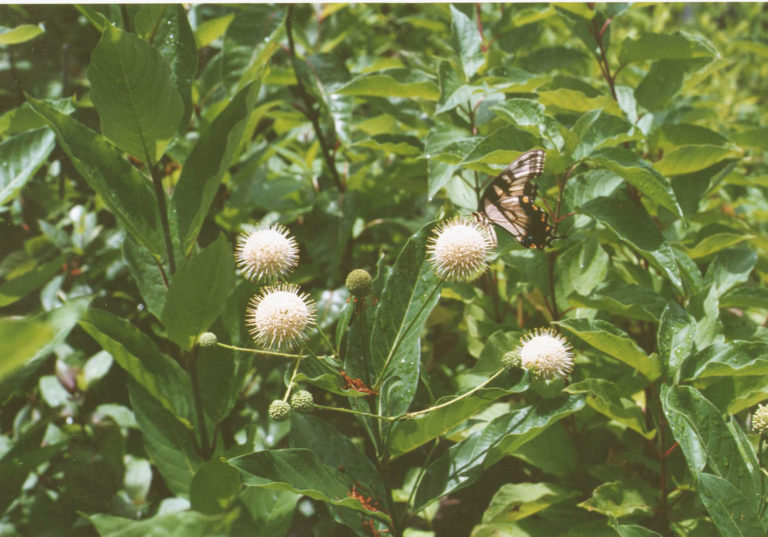Buttonbush is an open, woody, deciduous shrub usually 5-8′ tall (sometimes taller), with an irregular crown graced with many white, golf ball-sized, spherical flower clusters in June. The shrub is very ornamental, and the white, long lasting, pin-cushion like flowers are more often than not being visited by enthusiastic butterflies and/or bees. It is semi-aquatic. Although common, therefore, in wet habitats of the Eastern U.S. such as swamps, floodplains, pocosins and pond edges, even in standing water, Buttonbush can be cultivated in an upland garden setting with consistently moist but well drained soil as well. Seeds persist in attractive, compact balls into winter, providing food for various birds. Buttonbush flowers most prolifically in full sun and is tolerant of a range of circumneutral soils. It profits from hard pruning as flowers occur on new growth.
NURSERY HOURS
Wednesday: 10-4 Thursday: 10-6 Friday-Saturday: 10-4 Sunday: 12-4
Cephalanthus occidentalis

Key Info
Scientific Name: Cephalanthus occidentalis L.
Common Names: Button Bush, Button Willow, Honey Bells
Family Names: Rubiaceae (Madder or Coffee Family)
Plant Type: Tree / Shrub
Leaf Retention: Deciduous
Flower Color: White
Special Characteristics: Tolerates wet conditions, Showy fruit, Fragrant flowers, Attracts bees, Attracts butterflies, Attracts birds
Additional Info
Habit: Multi-stemmed, upright shrub with much branching and a pyrimidal crown; can sometimes achievee the stature of a small tree. The lower branches become woody and brown, while new growth is green or red. The root system is branching and woody.
Height: 6' to 12'
Spread: 4' to 8'
Soil Conditions: Average to wet, fertile soil with high organic content. Buttonbush grows in soil that is consistently moist, rather than wet, but will be smaller in size.
Leaves: Leaves are opposite or whorled, about 6" long, ovate to elliptic, glossy, bright green, with smooth margins.
Flowers (or reproductive structures: Each mature flowerhead is spherical, 1 - 1½ inches across, and is covered with small white or cream flowers. The florets have 4 stamens and one long style that projects out, giving the flowerhead a starburst look. Flowerheads are sweetly fragrant and may occur on the end of the branches or in the leaf axils. Flowering occurs over about 4 weeks in mid-summer.
Fruit: The flowerheads develop into spherical seedheads that turn red and eventually dark brown at maturity. Each flower is replaced by a small dry fruit with 2 cells, each cell containing a single seed.
Natural Distribution: swamps, lake sides, marshes, rocky slopes, wet thickets, wet depressions in black soil prairies, bogs, seeps, seasonal wetlands, and borders of rivers and small lakes. This shrub can form extensive colonies at some locations.
USDA Hardiness Zone: 5 to 10
USDA Wetland Indicator Status in NC: OBL
Pollination: Bees, butterflies, other insects.
Wildlife Connections: Buttonbush nectar and pollen attract many kinds of native bees, wasps, flies, skippers and butterflies as well as the Ruby Throated Hummingbirds. Other insects feed on the leaves and other parts of the plants: beetles, weevils, midges, bugs, larvae of moths. Buttobush is a larval host for Titan Sphinx and Hydrangea Sphinx (Illinoiswildflower.info). These plants also shade and cool water, protecting aquatic life of all kinds (fish, insects, amphibians).
Propagation: By seed.
